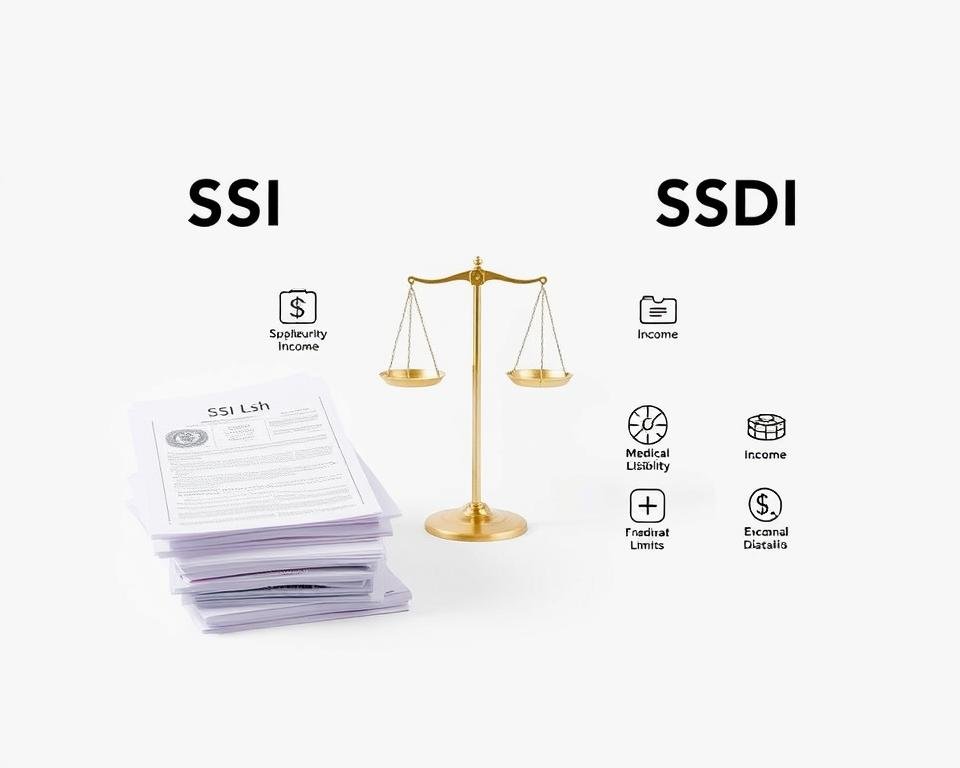Did you know more than 8 million people in the U.S. rely on Supplemental Security Income (SSI)? This fact highlights the need to understand both SSI and social security benefits. In our discussion, we explore the key differences between these two programs. SSI targets individuals with limited income and resources, in contrast, social security benefits are based on your work history. By understanding these differences, you can better navigate eligibility and the application processes.
Key Takeaways
- Over 8 million Americans depend on SSI for essential support.
- SSI is based on financial need, while social security benefits relate to work history.
- Understanding SSI and social security can help you make informed decisions.
- Different eligibility criteria exist for SSI and social security benefits.
- Knowing the differences aids in navigating the application process effectively.
Understanding SSI and Its Purpose
Supplemental Security Income (SSI) plays a critical role in aiding those who are financially vulnerable, including the elderly and disabled. It aims to provide necessary support, enabling recipients to cover basic needs daily.
What is Supplemental Security Income (SSI)?
SSI is a federal initiative that offers monetary aid to individuals with low income. It supports the basic living expenses for eligible people, especially those over 65 or with disabilities. This understanding helps to distinguish SSI from other support programs, highlighting its importance.
Eligibility Requirements for SSI
Qualifying for SSI requires proving a need, based on limited income and assets. By 2025, the income threshold for an individual will be $987 monthly, and resource limits will be $2,000 for singles and $3,000 for couples. These measures ensure the program reaches those genuinely in need.
Payment Structure of SSI
The SSI’s payment mechanism is based on federal criteria, offering monthly benefits for essentials such as food, clothing, and housing. To bolster the federal benefit, many states provide additional financial aid. This ensures a stronger support network for the beneficiaries.

Overview of Social Security Benefits
Grasping the intricacies of Social Security benefits is crucial for financial planning. These benefits are a lifeline for many, grounded in their work contributions and Social Security taxes paid. By understanding the available options, you’re better equipped to make sound choices.
What are Social Security Benefits?
Social Security benefits serve as a crucial support system for individuals. Funded by the taxes workers pay over their careers, this financial backing aids in maintaining stability through retirement, disabilities, or after a family member’s death.
Types of Social Security Benefits
Diverse Social Security benefits cater to various needs:
- Retirement Benefits: These are for those reaching retirement age with sufficient work credits.
- Disability Benefits (SSDI): For individuals unable to work due to serious medical conditions, demanding a solid work history.
- Survivor Benefits: These help the families of a deceased worker who qualified for Social Security.
Key Eligibility Criteria
To qualify for Social Security benefits, certain criteria must be met. Retirement benefits require a set number of work credits. For disability benefits, a serious medical condition and a good work record are needed. These standards are distinct from those for Supplemental Security Income (SSI), which is not dependent on work history.
Major Differences Between SSI and Social Security
Exploring the differences between SSI and Social Security reveals several crucial aspects. These differences are essential in determining which program better serves your needs. They include SSI’s income restrictions, the origin of their funds, and the variance in monthly payments compared to Social Security.
Income and Asset Limits
SSI operates on strict income and asset thresholds due to its means-tested nature. To be eligible, applicants must not exceed these limits. This requirement places the SSI vs SSDI comparison directly in the context of your fiscal health. Conversely, Social Security does not apply these financial criteria. Instead, it calculates benefits based on your earnings history.
Funding Sources and Administration
SSI is funded by general tax revenues, not the payroll taxes that sustain Social Security. This key distinction sheds light on the financial underpinnings of both initiatives. It particularly emphasizes Social Security’s reliance on the Federal Insurance Contributions Act (FICA) and its more predictable funding stream.
Monthly Benefit Amounts
The gap in monthly benefits between the two programs is noteworthy. Starting in 2025, SSI payments will begin at $967. Meanwhile, SSDI benefits have an average of $1,580 monthly, with a cap potentially reaching $4,018. These numbers clearly delineate the economic considerations crucial for choosing between these programs.

How to Apply for SSI and Social Security Benefits
Getting to grips with the steps for SSI and Social Security benefits applications is key. The process may initially seem complex, yet breaking it into smaller parts makes it manageable. Applications for SSI and Social Security can be made online, by phone, or in person. Each pathway has tailored steps to ensure your application is thorough and accurate.
Steps to Apply for SSI
- Visit the Social Security Administration (SSA) website or make an appointment at your local office.
- Complete the SSI application form, providing necessary personal information.
- Detail your income, resources, and living arrangements as required.
- Submit your application and await a decision from SSA.
Steps to Apply for Social Security Benefits
- Determine your eligibility and the specific type of benefits you are applying for.
- Choose your preferred application method: online, by phone, or in person.
- Complete the required forms, ensuring all information is accurate.
- Submit the application and monitor its status through the SSA portal or by contacting the office.
Important Documents Needed
For a smooth Social Security benefits application process, gather all essential documents beforehand. These should include:
- Proof of age, such as a birth certificate.
- Income verification, like pay stubs or tax returns.
- Resource documentation, including bank statements.
- Medical records if applying for disability benefits.

Common Misconceptions About SSI and Social Security
Understanding SSI and social security benefits can be complex, with many misconceptions prevalent. It’s not just for those unable to work. It also extends support to the elderly, highlighting the importance of understanding its full scope. Common myths can result in people missing out on crucial assistance.
Debunking Myths About SSI
SSI is often thought to benefit only the unemployed. However, it’s also a vital resource for seniors with modest incomes. Recognizing who is eligible and understanding the benefits is key. Surprisingly, about 36% of eligible seniors don’t apply, facing financial hardships unnecessarily.
Clarifying Social Security Misconceptions
There’s a false belief that social security is only for retirees. Yet, those with disabilities may access benefits earlier. This misconception can block essential financial support. To learn more, you can visit this source. Being informed about SSI and social security enables confident navigation through these options.
Resources for Further Information
Seeking accurate info on Supplemental Security Income (SSI) and Social Security benefits is crucial. Reliable sources help navigate their complexities. The Social Security Administration’s official website is vital. It offers detailed guidelines on applications, eligibility, and benefits. This site is a key resource for understanding these essential programs.
Where to Find SSI Information
Besides the official website, local community services and advocacy groups provide invaluable SSI insights. They assist with applications and clarify eligibility. Staffed with experts, these organizations can answer queries. They deal with the complexities of SSI, making the process smoother.
Social Security Administration Resources
The Social Security Administration offers helpful publications and online tools. These simplify the search for Social Security benefits info. With fact sheets and FAQs, they address common concerns. Explore these resources for a comprehensive understanding of your benefits.
Helpful Non-Profit Organizations
Non-profit organizations play a key role in explaining SSI and Social Security rights. They offer crucial information, advocacy, and support. Their help is essential in facing program-related challenges. Engaging with these groups can significantly boost your knowledge and support access to benefits.
FAQ
What is the primary difference between SSI and Social Security benefits?
What are the eligibility requirements for SSI?
How are Social Security benefits funded?
What types of Social Security benefits are available?
How do the monthly benefit amounts differ between SSI and Social Security?
FAQ
What is the primary difference between SSI and Social Security benefits?
Supplemental Security Income (SSI) is for individuals with low income and limited assets. Meanwhile, Social Security benefits are based on your employment record and the taxes paid.
What are the eligibility requirements for SSI?
To qualify for SSI, certain conditions must be met. These include being 65 or older, having a qualifying disability, and adhering to specific income and asset limits. For individuals, the income limit is 7 monthly and asset limit is ,000. For couples, these limits increase to ,000.
How are Social Security benefits funded?
Social Security is financed through payroll taxes via the Federal Insurance Contributions Act (FICA). Both employees and employers contribute, unlike the means-test for SSI.
What types of Social Security benefits are available?
Available types include retirement benefits and disability benefits (SSDI). There are also survivor benefits for eligible family members of the deceased.
How do the monthly benefit amounts differ between SSI and Social Security?
SSI benefits start around 7 monthly. SSDI benefits average
FAQ
What is the primary difference between SSI and Social Security benefits?
Supplemental Security Income (SSI) is for individuals with low income and limited assets. Meanwhile, Social Security benefits are based on your employment record and the taxes paid.
What are the eligibility requirements for SSI?
To qualify for SSI, certain conditions must be met. These include being 65 or older, having a qualifying disability, and adhering to specific income and asset limits. For individuals, the income limit is $987 monthly and asset limit is $2,000. For couples, these limits increase to $3,000.
How are Social Security benefits funded?
Social Security is financed through payroll taxes via the Federal Insurance Contributions Act (FICA). Both employees and employers contribute, unlike the means-test for SSI.
What types of Social Security benefits are available?
Available types include retirement benefits and disability benefits (SSDI). There are also survivor benefits for eligible family members of the deceased.
How do the monthly benefit amounts differ between SSI and Social Security?
SSI benefits start around $967 monthly. SSDI benefits average $1,580, with the highest reaching up to $4,018 per month.
What steps should I follow to apply for SSI?
To apply for SSI, options include online, phone, or in-person applications. Gathering all required documents ahead of time, like income and resource proof, is crucial.
What important documents do I need for Social Security benefits application?
Essential documents feature proof of work history, income, resources, and medical records for disability claims.
Are there common misconceptions about SSI?
One widespread misconception is that SSI is exclusively for the unemployed. In fact, it supports elderly individuals with limited income too.
Where can I find reliable information on Social Security benefits?
The Social Security Administration’s official website is the top source for facts on eligibility, application steps, and available benefits.
Can I receive both SSI and Social Security benefits?
Yes, qualifying for both allows you to receive benefits from SSI and Social Security. However, there are guidelines on the total benefits one can receive.
,580, with the highest reaching up to ,018 per month.
What steps should I follow to apply for SSI?
To apply for SSI, options include online, phone, or in-person applications. Gathering all required documents ahead of time, like income and resource proof, is crucial.
What important documents do I need for Social Security benefits application?
Essential documents feature proof of work history, income, resources, and medical records for disability claims.
Are there common misconceptions about SSI?
One widespread misconception is that SSI is exclusively for the unemployed. In fact, it supports elderly individuals with limited income too.
Where can I find reliable information on Social Security benefits?
The Social Security Administration’s official website is the top source for facts on eligibility, application steps, and available benefits.
Can I receive both SSI and Social Security benefits?
Yes, qualifying for both allows you to receive benefits from SSI and Social Security. However, there are guidelines on the total benefits one can receive.
